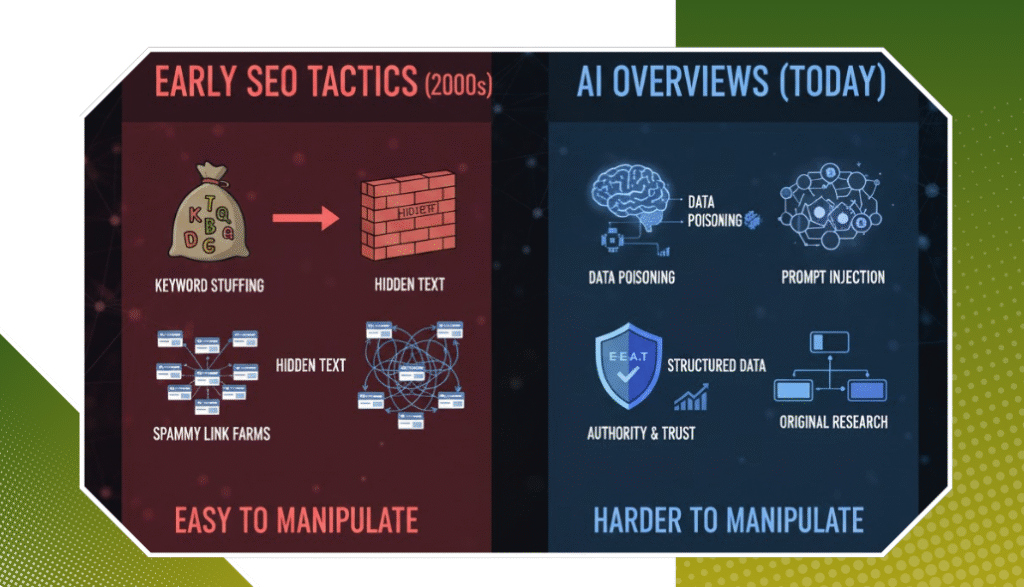If you’re searching for “Can I block my content from being included in Google AI Overview?” you’re asking the right question. This guide breaks down your options, explains what’s really happening behind the scenes, and helps you take back some control over how your content is used in this rapidly changing search landscape.
What Is Google AI Overview?
Google AI Overviews are designed to summarise content and provide users with quick answers to their questions. The intention behind this feature is to enhance the search process by showing answer content in abbreviated form. Content owners may not appreciate having their content emphasised in such overviews. Misrepresentation or user misunderstanding are generally the issues raised.
Can You Block Your Content?
As industry expert Kevin Indig clarifies, “You can’t opt out of [Google AI Overviews].” There is no absolute way to completely block content from being featured in Google AI Overviews, but there is a method to prevent Overview snippets from appearing in search results.
The Nosnippet Meta Tag
Employing the nosnippet meta tag is one of the ways content providers want to prevent their content from being displayed. The tag tells search engines, including Google, not to provide Overview snippets for a particular page when presenting search results. “It’s important to understand the implications of using this tag.
Consequences of Using the Nosnippet Meta Tag
Using the nosnippet meta tag has long-term implications. The tag not only prevents Overview snippets but also prevents regular text snippets, such as video previews and Google Discover visibility. Thus, using this tag can negatively impact click-through rates, resulting in reduced web traffic. According to a 2024 study by FirstPageSage, featured snippets have the highest click-through rate on Google SERPs, at an impressive 42.9%. Thus, most content creators would not want to miss such opportunities.
Why Should the Nosnippet Meta Tag Be Used?
In some instances, the nosnippet meta tag could be a suitable solution for some content providers.
- Control Over Brand Representation: For companies with landing pages tailored to specific calls to action or sales objectives, having the ability to manage how such pages appear in search results is paramount. Misrepresentation can create confusion among prospective customers, which is a significant issue for any brand.
- Guarding Confidential Information: Protection of sensitive or proprietary data is another strong reason to use the nosnippet meta tag. When data includes valuable business intelligence that must not be scraped or misrepresented, use of this tag is justified in order to safeguard that information.
- Maintaining Content Quality: Technical or up-to-date content deserves a good reason to apply the nosnippet meta tag. Automatically produced snippets can misinterpret sophisticated concepts, possibly degrading user experience.
Understanding AI Overviews and Content Usage
AI Overviews, formerly known as SGE (Search Generative Experience), utilise publicly available content to generate overviews that appear in search results. By Google’s policy, it is able to gather publicly available information to train its AI models. Thus, if content is available online, it can be used for Google AI overview.
The only way to completely block content from being inserted into these overviews is to delist the site from Google’s index. This extreme measure would significantly reduce a site’s visibility in search results.
Partial Protection of Content
For those unwilling to opt out completely, certain preview controls can potentially mitigate the impact of Google AI overviews to some degree. Although Google makes the final decision regarding content presentation, there are means such as the data-nosnippet HTML attribute and nosnippet meta tag that can indicate preferred controls on snippet display. These means can possibly limit how often content is added to AI Overviews, but there is no guarantee.
Current Content Control Options
Historically, Google has argued that publishers cannot completely opt out of their content being shown in AI Overview in Google. This has annoyed writers because it can cause their work to appear without their consent. Earlier techniques, such as using noindex or modifying robots.txt files, are viable options, but these methods have significant drawbacks. They can strip content from every search result, not merely the AI feature, and drastically reduce visibility in different search formats.
The Role of Preview Controls
As a counter to AI Overview in Google came up with preview controls, though not full-length content blocking. The controls are a directive on how content is to be displayed, but do not provide full protection from AI overviews.
Understanding Constraints
Content creators should be aware of the restrictions that accompany tools like the nosnippet meta tag or preview controls. Although these tools offer some control, Google ultimately determines what content is displayed in AI Overviews. This remains a persistent issue for those seeking greater control over their content.
Actionable Steps for Content Creators
Even without a complete opt-out procedure, content creators can still apply effective means of managing the online life of their content. Applying the nosnippet meta tag is still a possible step, but with caution due to its potential impact on search visibility.
Balanced Content Management Approach
A balance must be struck. Creators of content can weigh the potential benefits of visibility in search results against the desire to avoid being misrepresented in AI-generated overviews. The nature of the content, whether sensitive, complex, or crucial to brand identity, should inform this decision-making process.
Policy Awareness of Google
It is important to stay up-to-date with Google’s evolving policies regarding AI overviews and content representation. Being aware of new developments or updates can help content creators address the challenges of maintaining their online presence. Participating in industry forums, webinars, or discussions can help gain valuable insights on best practices and future trends regarding content control.
Testing Alternatives
While one solution comes in the form of the nosnippet meta tag, examining other content management practices may reveal additional ways to maintain useful information. Employing sophisticated SEO techniques can raise visibility without AI overviews, offering more user interaction possibilities.
Conclusion
Before you choose to block your content from being featured in Google’s AI Overviews, you must carefully weigh the possible consequences. Although the nosnippet meta tag does provide a means of opting out of such overviews, it could end up being more of a problem than a solution. Reduced visibility and click-through potential could negatively impact your content marketing and SEO initiatives.
Overall, if you’re not taking steps to avoid playing in featured snippets or AI overviews, you should be making use of the feature as part of your overall strategy. It will all boil down to brand awareness, SEO health, and content strategy. Every situation is unique, but carefully evaluating your content strategy will yield the best possible outcome for both your content and brand visibility.




